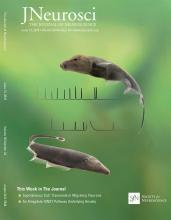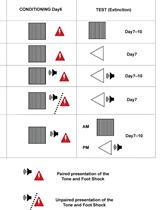- EN - English
- CN - 中文
Quantification of Prostaglandin E2 Concentration in Interstitial Fluid from the Hypothalamic Region of Free-moving Mice
"自由活动小鼠下丘脑区域间质液中前列腺素E2浓度的定量分析
发布: 2019年08月05日第9卷第15期 DOI: 10.21769/BioProtoc.3324 浏览次数: 5225
评审: Changyi ZhangEhsan KheradpezhouhAnonymous reviewer(s)
Abstract
Prostaglandin E2 (PGE2) is a well-established chemical mediator for the generation of the fever at the hypothalamus of the brain. PGE2 mediates fever generation via PGE receptor 3 (i.e., EP3) on neurons in the preoptic area. The role of PGE2 has been analyzed by measuring PGE2 concentration in cerebrospinal fluid (Ccsf); however, local PGE2 concentration at the hypothalamus may not necessarily be consistent with Ccsf. In this protocol, we introduce our method to measure directly the alteration in PGE2 concentration in interstitial fluid in the hypothalamus (Cisf) of awake (free-moving) mice using a microdialysis technique. Male mice (c57BL/6J) were anesthetized and fixed in the stereotaxic instrument, and a microdialysis probe was inserted into the hypothalamus through a guide cannula. On the fifth postoperative day, Cisf was monitored in free-moving mice that were intraperitoneally (i.p.) injected with lipopolysaccharide (LPS). PGE2 and other eicosanoids recovered in Krebs-Ringer phosphate buffer and defused through a microdialysis probe were extracted into ethyl acetate/formic acid and then quantified with LC-MS/MS. Our method is useful to understand the role of key regulators of prostaglandin concentration such as those of transporters, which have been unappreciated in inflammation-based brain diseases.
Keywords: Prostaglandin E2 (PGE2) (前列腺素E2)Background
PGE2 is intracellularly synthesized by cyclooxygenase pathways and released into extracellular spaces, where it binds to PGE receptors (i.e., EP1-4) to exhibit its activity. Prostanoids such as PGE2 are present in an anionic form under physiological conditions, and membrane transport has been suggested to be important for the local distribution and physiological action of PGE2 (Schuster, 2012; Nakanishi and Tamai, 2018). To date, several carrier proteins that are involved in PGE2 membrane transport have been identified and characterized; however, their roles in PGE2 distribution are not fully understood, particularly in the brain. Among these, organic anion transporting polypeptide 2A1 (OATP2A1) encoded by SLCO2A1 is a membrane transporter responsible for cellular uptake of prostanoids including PGE2, PGD2, and PGF2α, which are important for inflammatory reactions and homeostasis (Kanai et al., 1995). The roles of OATP2A1 in PGE2 disposition have been analyzed in SLCO2A1-deficient (SLCO2A1-/-) mice (Chang et al., 2010; Nakanishi et al., 2015). More recently, we reported that OATP2A1 located in intracellular organelles was involved in exocytotic PGE2 secretion from certain types of cells including macrophages (Shimada et al., 2015). Some previous articles described a potential role of OATP2A1 in the febrile response (Ivanov et al., 2003; Ivanov and Romanovsky, 2004). Indeed, OATP2A1 is expressed at the apical membranes of the choroid plexus (Tachikawa et al., 2012) and subarachnoidal blood vessels in rodents (Hosotani et al., 2015) and in primary cultured cerebral endothelial cells prepared from rats (Kis et al., 2006). Furthermore, in patients with Alzheimer’s disease, immunoreactivity for anti-OATP2A1 antibody has been reported in some glial cells including microglia and astrocytes (Choi et al., 2008). Therefore, our laboratory performed microdialysis to measure alteration in Cisf (concentration in interstitial fluid) of PGE2 at the hypothalamus of the brain to understand the physiological significance of OATP2A1 in LPS-induced fever generation. Our recent study determined Cisf of PGE2 at the hypothalamus in LPS-treated SLCO2A1+/+ and SLCO2A1-/- mice and clearly demonstrated that it was neither identical to Ccsf nor its concentration in hypothalamic tissues (Chyp) and was maintained by OATP2A1 independently (Nakamura et al., 2018). As far as we know, there is no report showing Cisf of PGE2 measured in free-moving small mammals like mice, although it has been analyzed by a microdialysis technique in rats (Gerozissis et al., 1995), rabbits (Kao, T. Y. et al., 2007; Kao, C. H. et al., 2007), and guinea pigs (Sehic et al., 1996). In the case of small animals such as mice, Cisf of PGE2 is expected to be lower than the detection limit of enzyme immunoassays, although an immunoassay is the most convenient and prevalent way to determine prostanoid concentration (Pradelles et al., 1985). However, protanoids can be easily detected using LC-MS/MS when extracted from biological fluids and concentrated using a solid phase column because accurate and sensitive quantification methods for prostanoids are established with LC-MS/MS (Schmidt et al., 2005; Cao et al., 2008). Fine microdialysis techniques to measure alteration in prostanoid concentration in the extracellular spaces of the brain in mouse models have been used widely in the field of neuroscience to promote an understanding of the mechanisms underlying neuroinflammation. Therefore, in this article, we present our protocols for analysis of PGE2 in microdialysis samples collected from the hypothalamus of mice, where PGE2 functions as a chemical mediator for fever generation.
Materials and Reagents
- 1.5-ml microtube (BIO-BIK, catalog number: CF-0150)
- 0.6-ml microtube (Thermo Fisher Scientific, catalog number: 502-GRD-Q)
- 2.0-ml microtube (Watson, catalog number: 132-620C)
- 10-ml glass conical tube (EMKS-16.5, Nichiden-Rika Glass, catalog number: 113111)
- Capillary glass tube (0.69 mm inner diameter, 1.19 mm outer diameter, 90 mm length, Drummond Scientific Company, catalog number: 3-000-210-G)
- 0.2-µm filter (Kanto Chemical, catalog number: 96923-00)
- Glass slide
- BD Lo-Dose U-100 insulin syringe (29 gauge of needle, Nippon Becton Dickinson, catalog number: 326666)
- Cotton wool (Osaki Medical, catalog number: 100006)
- Glass micropipette
a.Attach a capillary glass tube to the glass micropipette puller, and heat it with the instrument.
b.Pull a capillary glass tube according to the product protocol, and prepare the glass micropipette.
c.Brake the pipette at approximately 1 mm from the tip with tweezers before use. - Male c57BL/6J mice (10-25 weeks old)
- Pentobarbital sodium salt (Nacalai Tesque, catalog number: 26427-14)
- Paraffin (Leica, catalog number: 39601095)
- Liquid nitrogen
- Instant adhesive (Aron Alpha A, Daiichi-Sankyo)
- LPS O111:B4 (LPS, Sigma-Aldrich, catalog number: L4130)
- Formic acid (Wako Pure Chemical Industries, catalog number: 063-05895)
- Acetonitrile (Wako Pure Chemical Industries, catalog number: 015-08633)
- Ethyl acetate (Wako Pure Chemical Industries, catalog number: 058-00361)
- Ethanol (Wako Pure Chemical Industries, catalog number: 054-00461)
- Xylene (Wako Pure Chemical Industries, catalog number: 244-00081)
- Mayer's hematoxylin solution (Muto Pure Chemicals, catalog number: 30001)
- 1% eosin Y solution (Muto Pure Chemicals, catalog number: 32001)
- Paraformaldehyde (PFA, Wako Pure Chemical Industries, catalog number: 162-16065)
- Dental cement (Fuji I, GC, catalog number: 219AFB2X00208000)
- Woodworking glue (Konishi, catalog number: 10122)
- Dibutylhydroxytoluene (BHT, Wako Pure Chemical Industries, catalog number: 047-29451)
- PGE2 (Cayman Chemicals, catalog number: 14010)
- d4-PGE2 (Cayman Chemicals, catalog number: 314010)
- Glycerol (Nacalai Tesque, catalog number: 17045-65)
- KCl (Wako Pure Chemical Industries, catalog number: 163-03545)
- MgSO4 (Nacalai Tesque, catalog number: 210-32)
- NaH2PO4 (Wako Pure Chemical Industries, catalog number: 197-09705)
- Na2HPO4·12H2O (Kanto Chemical, catalog number: 37240-00)
- CaCl2 (Kanto Chemical, catalog number: 07057-00)
- NaCl (Wako Pure Chemical Industries, catalog number: 191-01665)
- HCl (5 N, Wako Pure Chemical Industries, catalog number: 081-05435)
- NaOH solution (5 N, Wako Pure Chemical Industries, catalog number: 196-05375)
- Pentobarbital solution (see Recipes)
- 10% glycerol solution (see Recipes)
- Krebs-Ringer phosphate buffer (KRPB, see Recipes)
- 0.5-M phosphate buffer (PB, see Recipes)
- 4% PFA solution (see Recipes)
Equipment
- Pipettes (Nichipet EXII, Nichiryo, catalog numbers: 00-NPX2-20, 00-NPX2-200, 00-NPX2-1000)
- Scissors (Natsume Seisakusho, catalog number: B-12H)
- Tweezers (Y-277, Hirasawa, catalog number: 9523)
- Dental drill
- Power supply (Minitor, catalog number: C2012)
- Rotary (Minitor, catalog number: M112)
- Diamond bar (diameter 0.8 mm, Minitor, catalog number: AD1403)
- -80 °C deep freezer (CLN-50U, Nihon Freezer)
- Microsyringe pump CMA/102 (CMA Microdialysis AB, catalog number: CMA/102)
- Microsyringe (Ito Seisakusho, catalog number: MS-GAN100)
- Stereotaxic instrument (Narishige, catalog number: SR-5M-HT)
- Anchor screws (Eicom, catalog number: AN-3)
- CMA7 guide cannula (CMA Microdialysis AB, catalog number: CMA P0000137)
- CMA7 microdialysis probe (1 mm membrane length, CMA Microdialysis AB, catalog number: CMA P000082)
- Device for free-movement (Eicom, catalog number: TSU-25)
- Acrylic cage (Eicom, catalog number: FC-25)
- Ultrasonic sonicator (QSonica, catalog number: XL2000)
- Glass micropipette puller (Narishige, catalog number: PC-10)
- Solid phase column (Oasis®MAX 3 cc (60 mg) extraction cartridges, Waters, catalog number 186000367)
- LCMS8050 (Shimadzu)
- LC-30AD (Shimadzu)
- Analytical column (Capcell Pak C18 IF2, 2.1 mm inner diameter x 100 mm, 2 µm, Shiseido, catalog number: 92887)
- Benchtop centrifuge (CF15RXII, Hitachi)
- Savant SpeedVac SPD2010 (Thermo Fisher Scientific, catalog number: SPD2010A-220)
Software
- LabSolution LCMS (Shimadzu)
Procedure
文章信息
版权信息
© 2019 The Authors; exclusive licensee Bio-protocol LLC.
如何引用
Readers should cite both the Bio-protocol article and the original research article where this protocol was used:
- Nakamura, Y., Sakaguchi, T., Tamai, I. and Nakanishi, T. (2019). Quantification of Prostaglandin E2 Concentration in Interstitial Fluid from the Hypothalamic Region of Free-moving Mice. Bio-protocol 9(15): e3324. DOI: 10.21769/BioProtoc.3324.
- Nakamura, Y., Nakanishi, T., Shimada, H., J., S., Aotani, R., Maruyama, S., Higuchi, K., Okura, T., Deguchi, Y. and Tamai, I. (2018). Prostaglandin transporter OATP2A1/SLCO2A1 is essential for body temperature regulation during fever. J Neurosci 38(24): 5584-5595.
分类
神经科学 > 神经系统疾病 > 动物模型
生物化学 > 其它化合物 > 小分子
您对这篇实验方法有问题吗?
在此处发布您的问题,我们将邀请本文作者来回答。同时,我们会将您的问题发布到Bio-protocol Exchange,以便寻求社区成员的帮助。
提问指南
+ 问题描述
写下详细的问题描述,包括所有有助于他人回答您问题的信息(例如实验过程、条件和相关图像等)。
Share
Bluesky
X
Copy link











